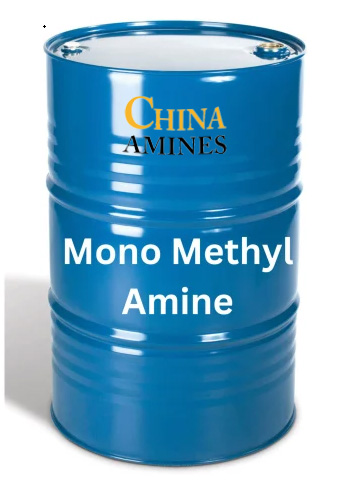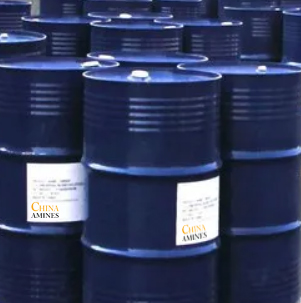Your Questions and Comments
Your sales and customer service desk partners within China Amines Co will continue to serve you. You can also contact us via our headquarter office-
Email:info@chinaamines.com
China Amines Co
Product Profile
1. Chemical Structure and Properties
Active Component:
Monomethylamine (MMA)
Molecular Formula:
CH₅N
Structural Formula:
CH₃NH₂ (primary aliphatic amine).
Solvent:
Methanol (MeOH), Molecular Formula: CH₃OH.
Solution Properties:
- Concentration: 30% w/w MMA in methanol.
- Physical State: Clear, colorless liquid with a pungent ammonia-like odor.
- Boiling Point: ~64–65°C (methanol dominates volatility).
- Density: ~0.85 g/cm³ at 20°C.
- pH: Strongly alkaline (pH ~12.5 due to MMA).
- Solubility: Fully miscible with water and polar organic solvents.
2. Industrial Applications
Pharmaceutical Synthesis:
- Key reagent in antibiotic production (e.g., cephalosporins) and antidepressants (e.g., fluoxetine intermediates).
Agrochemical Manufacturing:
- Intermediate for glyphosate herbicides and neonicotinoid insecticides (e.g., imidacloprid).
Organic Chemistry:
- Alkylation Agent: Used in quaternary ammonium salt synthesis for surfactants.
- Catalyst: Accelerates esterification and transesterification reactions.
Electronics:
- Etching and cleaning agent in semiconductor fabrication (e.g., gallium nitride processing).
3. Safety and Toxicology
Hazards of MMA:
- Inhalation: Irritates respiratory tract (LC50 rat, 4h: 2,500 ppm).
- Skin Contact: Corrosive; causes burns (rabbit skin LD50: 400 mg/kg).
- Eye Exposure: Severe damage, including blindness.
Acute Toxicity:
- Chronic Effects: Potential neurotoxicity and kidney damage.
Hazards of Methanol:
- Toxicity: Metabolizes to formic acid, causing metabolic acidosis, blindness, or death (oral LD50 rat: 5,600 mg/kg).
- Flammability: Highly flammable (flash point: 11°C).
Combined Risks:
- Vapor Exposure: Simultaneous inhalation of MMA and methanol vapors amplifies respiratory and CNS effects.
- Fire Hazard: Flammable liquid with explosive vapor-air mixtures.
Protection Measures:
- PPE: Acid-resistant gloves (e.g., Viton®), chemical goggles, and NIOSH-approved respirators.
- Engineering Controls: Explosion-proof ventilation, grounded containers to prevent static sparks.
4. Environmental and Regulatory Compliance
Environmental Impact:
- MMA: Moderately toxic to aquatic life (LC50 fish: 120 mg/L; EC50 daphnia: 85 mg/L).
- Methanol: Rapidly biodegradable but toxic to aquatic organisms (LC50 fish: 1,000 mg/L).
- Atmospheric Fate: MMA reacts with hydroxyl radicals (half-life ~2 days); methanol contributes to ozone formation.
Regulatory Frameworks:
- GB 13690-2009: Classified as Class 3.2 Flammable Liquid and Class 8.2 Corrosive Substance.
- OSHA PEL: 10 ppm (MMA), 200 ppm (methanol).
- EPA CERCLA: Reportable Quantity (RQ) = 100 lbs for MMA.
- CLP Regulation: Classified as Flammable Liquid (Cat. 2), Acute Tox. 2 (H330), and Skin Corr. 1B (H314).
- REACH: Requires SDS with handling and disposal protocols.
EU:
USA:
China:
Transportation:
UN Number: UN 1230 (Methanol solution, flammable).
Hazard Class: 3 (Flammable Liquid), Packing Group II.
5. Case Studies and Application Insights
Case 1: Glyphosate Herbicide Production
Process: MMA in methanol reacts with phosphorus trichloride to synthesize methylphosphonic acid, a glyphosate precursor.
Efficiency: 30% MMA/MeOH achieves 92% yield at 70°C (Bayer’s optimized batch process).
Case 2: Semiconductor Wafer Cleaning
Application: TSMC uses MMA/MeOH solutions to remove organic residues from silicon wafers.
Advantage: Lower residue vs. pure methanol, with 20% faster processing.
Comparison with Alternatives:
- Pros: Higher solubility for non-polar reagents; faster reaction kinetics.
- Cons: Increased flammability and methanol toxicity.



